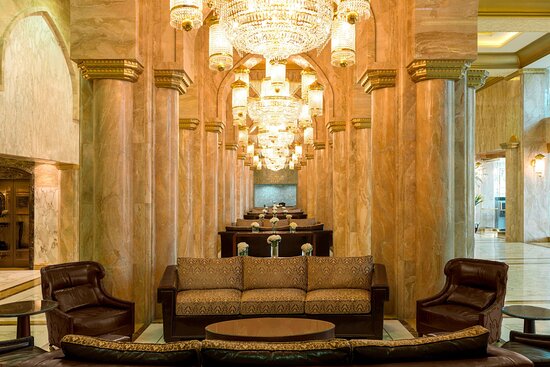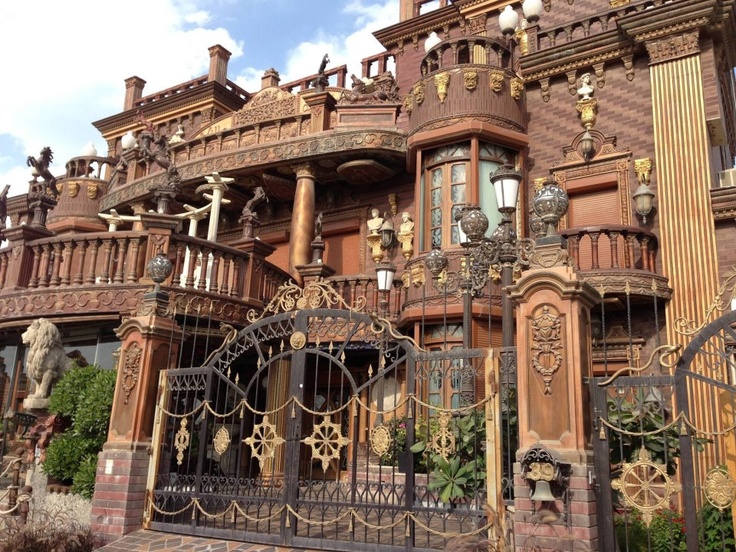Faisal Alhallaq
Kitsch and Kuwait
Faisal Alhallaq

Hotel in Kuwait
As a newly developed community it is understandable that we Kuwaitis wonder about how art can help us express and develop our cultural identity. Unfortunately, our cultural landscape is not what it used to be forty years ago. Arts such as theater, poetry, and music are losing their moral touch or integrity, which is leading to the stagnation of social development. The popular artistic taste in Kuwait has changed from what it used to be before the economic boom in the last century.
But what do economic changes have to do with the degeneration of artistic value? Over the last sixty years, Kuwait has witnessed economic and cultural upheaval that has radically changed its social and political landscape. It is no secret: the oil wealth has redefined not only the infrastructure but also how we Kuwaitis interact with and see each other. From the oil boom emerged a new cultural identity and, most prominently, new cultural challenges.
 During the 19th century, in industrialized Europe, an aesthetic phenomenon labelled “kitsch” started to take an uphold within the contemporary art scene. At that time, sociocultural changes caused by an economic boom had an important effect on art and culture. Kitsch is a German word that first appeared in Munich’s 19thcentury art bazars. It used to describe products of low artistic value. Today we would call them trashy, cheesy, or tasteless. These items were sold to the newly created middle class. Kitsch has no clear definition. The Oxford dictionary defines it as “works of art or objects that are popular but that are considered to have no real artistic value or not to be in good taste, for example, because they are sentimental.” Aesthetic terms are hard to reduce to precise definitions, but the features of a “kitschy” object can be described as lacking reflective cultural content, being inauthentic and repetitive, overly sentimental, and pretentious. Kitsch tends to be safe and generally does not challenge the subject matters it explores. Arts like theater, literature, music, film, painting, and even journalistic content can be criticized as kitsch if they manifest the formerly mentioned features. Objects that are mass produced and that we see in our everyday lives can also be kitsch: architecture, home decoration, furniture, fashion, souvenirs…
During the 19th century, in industrialized Europe, an aesthetic phenomenon labelled “kitsch” started to take an uphold within the contemporary art scene. At that time, sociocultural changes caused by an economic boom had an important effect on art and culture. Kitsch is a German word that first appeared in Munich’s 19thcentury art bazars. It used to describe products of low artistic value. Today we would call them trashy, cheesy, or tasteless. These items were sold to the newly created middle class. Kitsch has no clear definition. The Oxford dictionary defines it as “works of art or objects that are popular but that are considered to have no real artistic value or not to be in good taste, for example, because they are sentimental.” Aesthetic terms are hard to reduce to precise definitions, but the features of a “kitschy” object can be described as lacking reflective cultural content, being inauthentic and repetitive, overly sentimental, and pretentious. Kitsch tends to be safe and generally does not challenge the subject matters it explores. Arts like theater, literature, music, film, painting, and even journalistic content can be criticized as kitsch if they manifest the formerly mentioned features. Objects that are mass produced and that we see in our everyday lives can also be kitsch: architecture, home decoration, furniture, fashion, souvenirs…
The emergence of a degraded aesthetic taste of the masses in a politically very tense Europe appears to have had a kind of tipping-point effect on aesthetics all over the world. A question for aestheticians at the time was: can art imprison us just like it had freed us?
It is a metaphysical question already asked by philosophers over two millennia ago, but the question is still relevant in modern times. Some critics are skeptical about the idea of kitsch being imprisoning or degrading. For these critics, the phenomenon is so manifest in our modern culture that it has become the norm. But the question is being articulated because of the cultural shift that kitsch has effectuated.
Kuwaitis use words like “hailag” or “egaidy” to describe kitsch objects that we find inappropriate or of low aesthetic value. Similar to the cultural shift that happened in 19th century Europe, our culture has seen a shift in aesthetic taste, too, only a hundred years later. The difference is that our use of words like hailag and egaidy to describe things that we judge beneath our personal aesthetic standards can be problematic to our communal identity. The word egaidy denotes an individual from the Syrian-Iraqi tribe called Egaidat. People from this tribe are spread over the Arabian Peninsula and also exist in Kuwait. The other word hailag comes from the famine that occurred in the 19th century in an area between Persia and the Arabian Gulf region. The people who emigrated from Persia to Kuwait were called hailag because there were doomed due to the famine. The word’s use and its association with inappropriate taste can be explained as such: the immigrants from the famine region did not know how to speak proper Arabic, so improper social objects or behaviors would be designated by using this word.
At present, Kuwaitis use ethnic terms to describe instances of bad aesthetic expression that look like kitsch. Does this mean that our culture is increasingly racially polarized and has become elitest? I don’t think so. It rather shows that Kuwait has always had a diverse ethnic identity. However, the shift in aesthetic taste that came with the economic boom can be subtly polarizing if Kuwaitis do not invest time and effort into upgrading their arts in the way they did in the first half of the last century. Authenticity and creativity must be our priority when it comes to the development and the maintenance of our cultural identity. It also implies having the courage to face critique. Faisal Alhallaq is a graduate of the American University of Kuwait. He is currently pursuing a MA in Philosophy at Kuwait University.
Faisal Alhallaq is a graduate of the American University of Kuwait. He is currently pursuing a MA in Philosophy at Kuwait University.
Back to Meridian 5.png)

